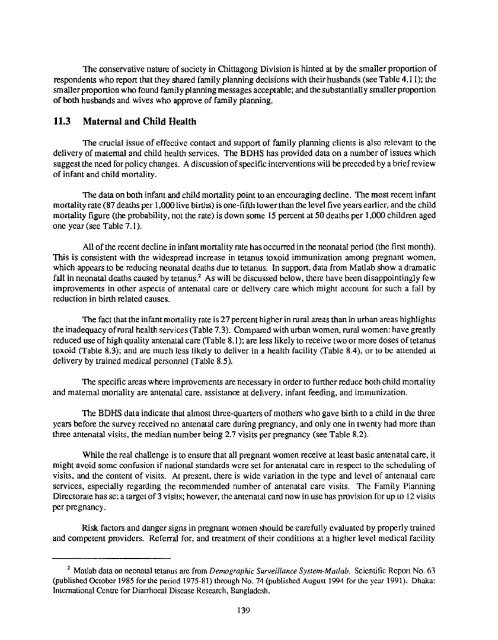Bangladesh 1993-1994 Demographic and Health ... - Measure DHS
Bangladesh 1993-1994 Demographic and Health ... - Measure DHS
Bangladesh 1993-1994 Demographic and Health ... - Measure DHS
- No tags were found...
You also want an ePaper? Increase the reach of your titles
YUMPU automatically turns print PDFs into web optimized ePapers that Google loves.
The conservative nature of society in Chittagong Division is hinted at by the smaller proportion ofrespondents who report that they shared family planning decisions with their husb<strong>and</strong>s (see Table 4.11); thesmaller proportion who found family planning messages acceptable; <strong>and</strong> the substantially smaller proportionof both husb<strong>and</strong>s <strong>and</strong> wives who approve of family planning.11.3 Maternal <strong>and</strong> Child <strong>Health</strong>The crucial issue of effective contact <strong>and</strong> support of family planning clients is also relevant to thedelivery of matemal <strong>and</strong> child health services. The B<strong>DHS</strong> has provided data on a number of issues whichsuggest the need for policy changes. A discussion of specific interventions will be preceded by a brief reviewof infant <strong>and</strong> child mortality.The data on both infant <strong>and</strong> child mortality point to an encouraging decline. The most recent infantmortality rate (87 deaths per 1,000 live births) is one-fifth lower than the level five years earlier, <strong>and</strong> the childmortality figure (the probability, not the rate) is down some 15 percent at 50 deaths per 1,000 children agedone year (see Table 7.1).All of the recent decline in infant mortality rate has occurred in the neonatal period (the 11rst month).This is consistent with the widespread increase in tetanus toxoid immunization among pregnant women,which appears to be reducing neonatal deaths due to tetanus. In support, data from Matiab show a dramaticfall in neonatal deaths caused by tetanus. 2 As will be discussed below, there have been disappointingly fewimprovements in other aspects of antenatal care or delivery care which might account for such a fall byreduction in birth related causes.The fact that the infant mortality rate is 27 percent higher in rural areas than in urban areas highlightsthe inadequacy of roral health services (Table 7.3). Compared with urban women, rural women: have greatlyreduced use of high quality antenatal care (Table 8.1); are less likely to receive two or more doses of tetanustoxoid (Table 8.3); <strong>and</strong> are much less likely to deliver in a health facility (Table 8.4), or to be attended atdelivery by trained medical personnel (TaNe 8.5).The specific areas where improvements are necessary in order to further reduce both child mortality<strong>and</strong> maternal mortality are antenatal care, assistance at delivery, infant feeding, <strong>and</strong> immunization.The B<strong>DHS</strong> data indicate that almost three-quarters of mothers who gave birth to a child in the threeyears before the survey received no antenatal care during pregnancy, <strong>and</strong> only one in twenty had more thanthree antenatal visits, the median number being 2.7 visits per pregnancy (see Table 8.2).While the real challenge is to ensure that all pregnant women receive at least basic antenatal care, itmight avoid some confusion if national st<strong>and</strong>ards were set for antenatal care in respect to the scheduling ofvisits, <strong>and</strong> the content of visits. At present, there is wide variation in the type <strong>and</strong> level of antenatal careservices, especially regarding the recommended number of antenatal care visits. The Family PlanningDirectorate has set a target of 3 visits; however, the antenatal card now in use has provision for up to 12 visitsper pregnancy.Risk factors <strong>and</strong> danger signs in pregnant women should be carefully evaluated by properly trained<strong>and</strong> competent providers. Referral for, <strong>and</strong> treatment of their conditions at a higher level medical facility2 Maflab data on neonatal tetanus are from <strong>Demographic</strong> Surveillance System-Matlab. Scientific Report No. 63(published October 1985 for the period 1975-81) through No. 74 (published August <strong>1994</strong> for the year 1991). Dhaka:International Centre for Diarrhoeal Disease Research, <strong>Bangladesh</strong>.139








![Obtaining Informed Consent for HIV Testing [QRS4] - Measure DHS](https://img.yumpu.com/49850117/1/190x245/obtaining-informed-consent-for-hiv-testing-qrs4-measure-dhs.jpg?quality=85)







